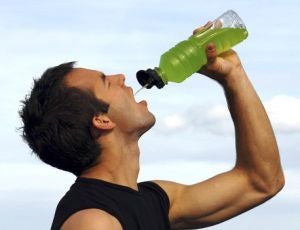Is Your Sports Drink Good Enough?

The basic sports drink formula hasn’t changed in 45 years. That doesn’t mean newer is better.
Written by: Matt Fitzgerald
In 1965 a 37-year-old associate professor of medicine at the University of Florida developed the first sports drink, which became known as Gatorade. It contained water to rehydrate athletes, salt and potassium to replace the minerals they lost in sweat, and sugar to maintain blood glucose. Over the next several years this concoction was extensively studied and found to significantly boost athletic performance compared to plain water.
Cade did not nail his sports drink formulation on the first try. He had to fiddle with various concentrations of minerals and carbs to arrive at the formulation that had the greatest beneficial impact on hydration and exercise performance. Scientists use the term “osmolality” to refer to the total concentration of dissolved particles in a solution. A solution is said to be hypotonic when its total concentration of dissolved particles is less than that of the body’s cells and blood. A solution is said to be isotonic when the concentration is equal. And “hypertonic” describes a solution that has a greater concentration of dissolved particles than the cells and blood.
Related: The Other Benefits Of Sports Drinks
In theory, isotonic beverages are absorbed more quickly through the intestine into the blood stream because the gastrointestinal system does not have to do as much to adjust the osmolality of the fluid. But Cade ultimately settled on a formulation that was slightly hypertonic, because adding a little more carbohydrate yielded the separate benefits of making the drink more palatable and providing more energy to the working muscles.
In the 46 years since Robert Cade developed the first sports drink, many other sports drinks have come to market. Not all of these drinks have the same osmolality. Some are isotonic, and others are even hypotonic. It is usually a lower level of carbohydrate that reduces the osmolality of a hypotonic sports drink, but mineral concentrations also have an effect.
“Low sugar” sports drink that are hypotonic because of their lower sugar concentration have become popular lately. The makers of some of these sports drinks argue that their products are absorbed even faster than more traditional formulations. In a recent study, researchers at Massey University in New Zealand directly compared the effects of a hypotonic sports drink (3.9 percent carbs), an isotonic sports drink (7.6 percent carbs), and a hypertonic sports drink (6 percent carbs), as well as a placebo (flavored water), on hydration and exercise performance.
Eleven athletes were recruited as subjects for the study. Each of them rode at a moderate intensity on an exercise bike for two hours and then rode briefly at increasing intensities until they reached exhaustion. This test was repeated on four separate occasions. Subjects consumed one of the four beverages on each occasion in random order until they had tried all four.
More from Competitor.com: Should You Be Concerned About Calories In Sports Drinks?
The researchers found that blood volume decreased most during the workout in which the subjects consumed water. It decreased by smaller and similar amounts with all three of the sports drinks. In other words, the sports drinks hydrated better than water, and more or less equally among themselves. The same pattern of results was seen with respect to performance. The subjects performed significantly worse in the incremental test to exhaustion at the end of the workout in which they drank water. Performance differentials were small and inconclusive among the three sports drinks.
In the marketing of sports-related products, including sports nutrition products, “newer” is often equated with better. But as the results of this new study indicate, the traditional sports drink formulation that has existed for nearly five decades works as well as newer alternatives.
There are meaningful differences in sports drink formulations. For example, subjects in the study just described reported lower levels of gut comfort with the isotonic sports drink than with the other two. So you may need to experiment a little to find the product that works best for you. But as this study also shows, all sports drinks hydrate better and improve performance more than water.
****
Matt Fitzgerald is the author of Iron War: Dave Scott, Mark Allen & The Greatest Race Ever Run (VeloPress 2011) and a Coach and Training Intelligence Specialist for PEAR Sports. Find out more at mattfizgerald.org.